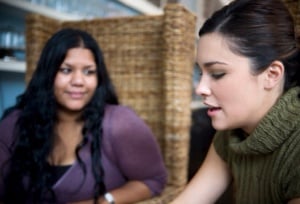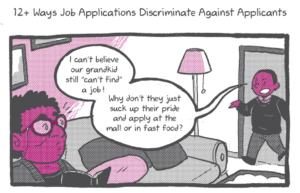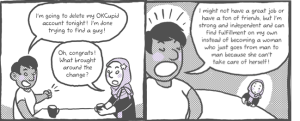
Source: Huffington Post
Originally published in the Huffington Post and republished here with the author’s permission.
In 1994, Dorothy Gaines was a nurse technician and PTA parent raising her younger sister and brother and three children alone in Mobile, Alabama after the death of her husband. Local drug dealers, desperate to reduce their own sentences, named her as an accomplice in their sale of crack cocaine.
Their self-contradictory testimony was the only evidence against her, yet her court-appointed lawyer failed to cross-examine them or raise a defense. She was found guilty of conspiracy to distribute crack cocaine.
Her nine-year-old son Phillip jumped in the judge’s lap at sentencing and begged the judge not to take away his mother. Dorothy was sentenced to 19 years and seven months in federal prison.
Her first time on a plane, she flew 1,300 miles to the same Connecticut prison that later held Piper Kerman, the author and real-life subject of Orange Is the New Black.
Piper, Red, Suzanne, and the other colorful characters on Jenji Kohan’s Netflix show Orange Is the New Black have become the authoritative source on women’s prisons for millions of Americans.
But as we binge-watch season three to find out what happens to Rosa, keep in mind that the show misrepresents the real women’s federal prison population.
If Netflix is the closest you’ve gotten to women’s federal prison, here are four things that you need to know:
1. Most Women in Federal Prison Committed Low-Level Drug Crimes
People think of federal prison as a lockup for the nation’s worst criminals. The OITNB writers got pretty creative, from Pennsatucky murdering a nurse for commenting on her seven abortions to Miss Claudette trafficking children to clean houses.
But while it may not make for an exciting backstory, six in ten women in real federal prison are there for nonviolent drug crimes.
For every woman who has committed murder, there are 99 drug offenders. Almost none of the 99 are international drug smugglers like Alex Vause; most of the women incarcerated for crack cocaine or methamphetamine were caught with less than 100 grams, the weight of an average bar of soap.
Many sold small amounts of drugs to support their own addiction or, like Taystee and Daya, worked as a low-level assistant in a relative’s operation.
Despite these minimal roles, female drug offenders serve an average of over seven years, more than international heroin trafficker Cleary Wolters, the real-life subject for Alex Vause (she served five years and ten months).
Frequently, low-level assistants serve more than their own bosses. Why?
Like Dorothy Gaines, most defendants can’t afford a private attorney, and court-appointed attorneys often barely have time to read a defendant’s case before defending them in court, much less conduct the research needed for a decent defense.
In addition, prosecutors reduce sentences for those who furnish “valuable” information, like the men who testified against Dorothy. The low-level employees have no valuable information to give.
If the show had 99 Taystees for every Pennsatucky, it would have fewer knife fights, but it would more accurately illustrate the human and financial waste of locking women up for low-level drug crimes.
Our prisons currently house hundreds of thousands of mostly low-level drug dealers at nearly $30,000 per person per year. Since cocaine and heroin are worth three and eight times their weight in gold, respectively, locking up a dealer simply creates a lucrative new job opening.
When dealers get out of prison, having “paid their debt to society” but branded with a criminal record, they struggle to find legal employment. 68% are rearrested within three years.
In the show, Taystee reoffends shortly after getting out because she’s sleeping on her second cousin’s floor, can’t afford to eat, can’t find an apartment and can’t build a new life.
In reality, her cousin might not have let her sleep on the floor, since allowing a felon into public housing is grounds for eviction.
2. Most Women in Federal Prison Have Children Under 18
After writing a letter a day for six years, Dorothy Gaines caught the attention of civil rights advocates, the news media and finally President Clinton.
In 2000, he commuted her sentence, allowing her to return home to her family. Yet her family is still haunted by the prison system.
Dorothy has struggled to find work with a felony conviction on her record. During her first year in prison, her son Phillip attempted suicide three times, and her eldest daughter Natasha had to drop out of her nursing program to take care of him.
Dorothy has struggled to undo the damage of the six years she lost with her son. Phillip went from a Boy Scout on the honor roll to a ninth-grade dropout.
He has since been convicted of cocaine possession and robbing two men at a gas station. Psychiatrists told Dorothy that he should have been treated long ago for schizophrenia and depression.
Last year, Phillip was found guilty of a second robbery and sentenced to 20 years in prison. Just like Dorothy in 1994, he leaves behind a nine-year-old child.
We only see a couple of mothers on the show, but in real federal prison, four in five women have children, and over half have kids under 18. Like Phillip Gaines, these children do the time with their mothers.
The federal women’s prison system includes twelve small-capacity, minimum-security prison camps, four low-security prisons, and one medium-security prison in the entire US, so Larry’s short drive to visit Piper is actually quite unusual.
Like Dorothy, many mothers are incarcerated hundreds or thousands of miles away from their children, which explains why almost half of all mothers in federal prison never receive a single visit from their kids.
The prevalence of parental incarceration is frightening – roughly 10 million American children have experienced parental incarceration, and 2.7 million currently have a parent in prison. Some lose their mothers permanently; incarceration increases a mother’s chance of losing children to foster care by a factor of five.
Of course, many children do not follow their parent to prison like Phillip, but studies find a significant and unsurprising association between parental incarceration and anger issues, attention problems in school, and youth homelessness.
Does taking mothers away from their kids make our nation a safer, healthier place?
3. Many Women Need Counseling and Medical Help, Not Prison
While Suzanne, Jimmy, and Lorna are the only characters who display any mental health issues on the show, in reality, 62% of all women in federal prison suffer mental health problems.
Jails are now our country’s largest mental health providers.
And if you want to find crime victims, look in prison.
The vast majority of women in federal prison have been victims of physical or sexual abuse. Among those who sold drugs to feed their own addiction, roughly two thirds were abused as children.
90% of women incarcerated for killing their male partner had been abused by them, and most committed their crime out of self-defense.
We should not excuse their crimes by pointing to histories of abuse, but we should wonder if prisons are, as Piper Kerman herself writes, “a place where the US government now puts not only the dangerous, but also the inconvenient.”
Are we incarcerating these women to resolve societal problems – or to hide them?
4. This Is All New
OITNB is truly a product of our time, not just because of the high production value, crude language, and lesbian sex, but also because women’s prisons barely existed 30 years ago.
There are ten times as many women in prison today as there were in 1980, an explosion twice as large as that of the male prison population.
With one twentieth of the world’s population, we now have a quarter of the world’s male prisoners and a third of the world’s female prisoners. American women are nine to 17 times more likely to be incarcerated than women in Canada, England, France, Germany, and China.
Our record rate of incarcerating women originates largely from the War on Drugs itself.
As the media galvanized public fear over crack cocaine use in the mid-1980s, Congress established “mandatory minimum” sentences for people caught with small amounts of drugs.
Judges were forced to hand out five-year sentences for possession of five grams – the weight of five Splenda packets – of crack cocaine or methamphetamine. (In 2010, the threshold for crack cocaine was raised to 28 grams.)
A prior drug felony conviction raises the minimum to ten years. Though the Second Amendment protects gun ownership, if the offender keeps firearms in the house, even if they have nothing to do with the crime, prosecutors can add five years for the first and 25 years for each additional gun.
Judges know that women like Taystee, Daya, and Nicky Nichols are low-level assistants or drug addicts, but they are forced to sentence them as kingpins based on the drug weight and gun count found by police and charged by prosecutors.
While federal judges normally stay out of policy discussions, they are speaking out against Congress’s disastrous mandatory minimum laws, calling them “unjust,” “gut-wrenching,” and “cruel and unusual.”
One of the lead advocates of clemency for Dorothy Gaines was the man who sentenced her, Judge Alex T. Howard.
After 30 years, Americans are realizing that “getting tough on crime” is bad for America.
No matter what punishment small-time drug dealers deserve, incarcerating them also punishes their children, taxpayers and American society as a whole.
OITNB is helping to wake us up, but it isn’t perfect. The show underrepresents the nonviolent, low-level drug offenders, mothers, and abuse victims who dominate our prisons.
While it highlights prison mismanagement and the human stories of women behind bars, it could raise a more fundamental question: Is incarcerating these women worth $30,000 plus the damage done to the women, their children, and our communities?
Take action now:
1. Share this article with other OITNB fans on Twitter.
2. Support Families Against Mandatory Minimums and Families for Justice As Healing, two organizations fighting to bring home women victimized by mandatory minimum sentences
3. Hear an inspirational speech by Dorothy Gaines herself, who now travels the country speaking out about mandatory minimum sentences and the War on Drugs
4. Host a local speaker from Law Enforcement Against Prohibition (LEAP), an organization of law enforcement officers who believe that ending mass incarceration and the War on Drugs would make our country safer.
5. Dorothy invites you to write to her son at: Phillip Gaines #268485, Donaldson Correctional Facility, 100 Warrior Lane, Bessemer, AL 35023
[do_widget id=’text-101′]
Amos Irwin is Chief of Staff at the Criminal Justice Policy Foundation, where he pioneers strategies to reform American drug policy, and Assistant Training Director at Law Enforcement Against Prohibition. He is also a founding member of Defying Gender Roles. He has taught courses at Northeastern and Tufts Universities on macroeconomics, Chin,a and the War on Drugs. Follow him on Twitter @realamosirwin.
Search our 3000+ articles!
Read our articles about:
Our online racial justice training
Used by hundreds of universities, non-profits, and businesses.
Click to learn more




















